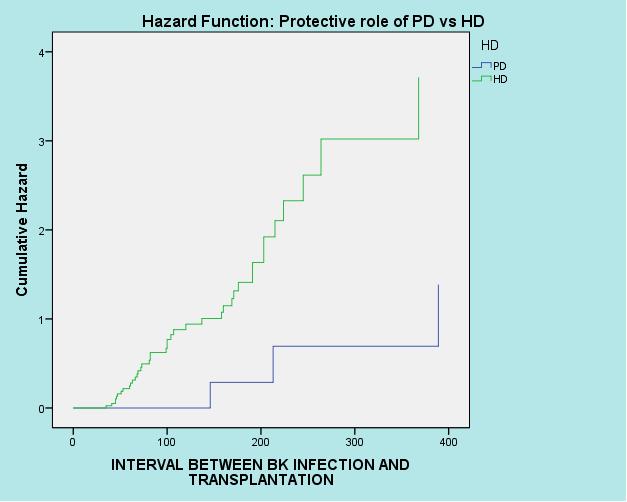Risk Factors for Polyomavirus Infection After Renal Transplantation: Introduction of the Protective Effect of Peritoneal Dialysis.
S. Hosseini-Moghaddam, Q. Xu, J. Kum, H. Alharbi, A. Jevnikar, M. John, G. Singh, S. Parsons, M. Edgar, P. Luke.
Medicine, Western University, London Health Sciences Centre, London, ON, Canada
Meeting: 2017 American Transplant Congress
Abstract number: A290
Keywords: Immunosuppression, Infection, Kidney/liver transplantation, Nephropathy
Session Information
Session Name: Poster Session A: Viral Conundrums
Session Type: Poster Session
Date: Saturday, April 29, 2017
Session Time: 5:30pm-7:30pm
 Presentation Time: 5:30pm-7:30pm
Presentation Time: 5:30pm-7:30pm
Location: Hall D1
Objective: To determine the roles of pre and post-transplant variables on the risk of BK virus infection after renal transplantation.
Method: This study is a single- group cohort of 176 renal allograft recipients with one year followup after transplantation, between July 2012 and July 2014. Table-1 presents background information.
| Median (range) age at the time of transplantation | 53 (14-82) years |
| Gendder, male | 111 (63%) |
| Retransplantation | 28 (15.9%) |
| Living vs deceased donor | 37 vs 137 |
| Interval between dialysis and Transplantation | Median (range): 24 (2-312) months |
All recipients received similar maintenance immunosuppression. Univariate, multivariate and survival analysis were performed.
Results:45 patients (25.6%) developed BK infection in the first year after transplantation. Recipient age or gender, underlying renal diseases, HLA-mismatches, blood groups, living vs deceased donor, donation after cardiac vs brain death, donor gender, steroid therapy before transplantation, retransplantation, induction regimens, CMV serostatus, cold ischemia time, interval between transplantation and ureteral stent removal, delayed graft function, allograft rejection, median tacrolimus level in the first 3 months or 4-12 months after transplant, dose of immunosuppressives, plasma exchange, IVIG, and fluoroquinolones did not significantly affect the risk of BKV infection. Median (IQR) donor age [54.3 (49-61.7) vs 49.9, (33.4-56.2), p=0.003]; and peritoneal dialysis vs hemodialysis [6/46 (13%) vs 35/104 (30.7%), OR= 0.3,CI95%:0.1-0.8] significantly affected the risk.  Conclusion: The baseline risk of BKV infection does not seem to be similar in PD and HD patients. This finding could be due to B cell lymphopenia, poorer antibody mediated immunity, weaker Th2 response, and hypercytokinemia in HD patients. Further comparative studies are required.
Conclusion: The baseline risk of BKV infection does not seem to be similar in PD and HD patients. This finding could be due to B cell lymphopenia, poorer antibody mediated immunity, weaker Th2 response, and hypercytokinemia in HD patients. Further comparative studies are required.
CITATION INFORMATION: Hosseini-Moghaddam S, Xu Q, Kum J, Alharbi H, Jevnikar A, John M, Singh G, Parsons S, Edgar M, Luke P. Risk Factors for Polyomavirus Infection After Renal Transplantation: Introduction of the Protective Effect of Peritoneal Dialysis. Am J Transplant. 2017;17 (suppl 3).
To cite this abstract in AMA style:
Hosseini-Moghaddam S, Xu Q, Kum J, Alharbi H, Jevnikar A, John M, Singh G, Parsons S, Edgar M, Luke P. Risk Factors for Polyomavirus Infection After Renal Transplantation: Introduction of the Protective Effect of Peritoneal Dialysis. [abstract]. Am J Transplant. 2017; 17 (suppl 3). https://atcmeetingabstracts.com/abstract/risk-factors-for-polyomavirus-infection-after-renal-transplantation-introduction-of-the-protective-effect-of-peritoneal-dialysis/. Accessed December 24, 2025.« Back to 2017 American Transplant Congress
